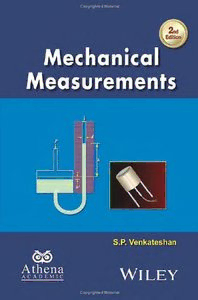
Mechanical Measurements PDF
Preview Mechanical Measurements
MECHANICAL MEASUREMENTS (2nd Edition) MECHANICAL MEASUREMENTS (2nd Edition) S.P. Venkateshan Professor Emeritus Department of Mechanical Engineering Indian Institute of Technology Madras Chennai, INDIA John Wiley & Sons Ltd. Mechanical Measurements (2nd Edition) © 2015 S.P. Venkateshan First Edition: 2008 Reprint: 2009, 2010, 2013 Second Edition: 2015 This Edition Published by John Wiley & Sons Ltd The Atrium, Southern Gate Chichester, West Sussex PO19 8SQ United Kingdom Tel : +44 (0)1243 779777 Fax : +44 (0)1243 775878 e-mail : [email protected] Web : www.wiley.com For distribution in rest of the world other than the Indian sub-continent Under licence from: Athena Academic Ltd. Suit LP24700, Lower Ground Floor 145-157 St. John Street, London, ECIV 4PW. United Kingdom Email: [email protected] Web: athenaacademic.com ISBN : 978-11-1911-556-4 All rights reserved. No part of this publication may be reproduced, stored in a retrieval system, or transmitted in any form or by any means, electronic, mechanical, photocopying, recording or otherwise, except as permitted by the UK Copyright, Designs and Patents Act 1988, without the prior permission of the publisher. Designations used by companies to distinguish their products are often claimed as trademarks. All brand names and product names used in this book are trade names, service marks, trademarks or registered trademarks of their respective owners. The publisher is not associated with any product or vendor mentioned in this book. Library Congress Cataloging-in-Publication Data A catalogue record for this book is available from the British Library. Dedicated to the Shakkottai Family Preface to the second edition The second edition of the book has been thoroughly revised and all errors that have come to my notice have been corrected. Additions have been made at various places in the book. Notable additions are in the statistical analysis of measured data in Module I. Important questions regarding normality of deviations and identification of outliers have been discussed in great detail. These should interest the advanced reader who is looking for an understanding of these issues. Thermistors have been described in greaterdetailinChpater4. Also,thelinereversaltechniqueofmeasuringgas temperature has been described in greater detail. Theory of the integrating sphere has been discussed in detail in Chapter 12. Module V has been augmentedwithmoreexamplesfromlaboratorypractice. Exercisesarenow positionedattheendofeachmodule. Manynewexerciseproblemshavebeen addedinthisedition. The modules have been rearranged with the number of chapters going up by one to a total of sixteen chapters in this edition. Many references are indicated as footnotes in the text apart from the bibliography and the list of references given in the Appendix. All illustrations have been redrawn for this edition using ‘tikz’ - a program environment compatible with ‘latex’. All graphs have been replotted for this edition using QtiPlot. In general these were done to improve the quality of the illustrations as also to bring uniformityintheformat. Itishopedthatthesecondeditionwillbereceivedwiththesameenthusi- asmastheoriginaleditionbythestudentcommunity. S.P.Venkateshan vii viii Preface to the first edition In recent times there have been rapid changes in the way we perceive measurements because new technologies have become accessible to any one who cares to use them. Many of the instruments that one takes for granted now were actually not there when I started my engineering studies in the 1960’s. Training we received in those days, in Mechanical Engineering did not include a study of “Mechanical Measurements”. Whatever was learnt was purely by doing experiments in various laboratory classes! Electrical Engineers were better off because they studied “Electrical Measurements” forayear. Thesemestersystemwastobeintroducedfarinthefuture. Even when “Mechanical Measurements” was introduced as a subject of study the principles of measurements were never discussed fully, the emphasis being the descriptive study of instruments! In those days an average mechanical engineer did not have any background in measurement errors and their analysis. Certainly he did not know much about regression, design of experimentsandrelatedconcepts. At that time the integrated chip was to appear in the future and the digital computer was in its infancy. We have seen revolutionary changes in both these areas. These developments have changed the way we look at experiments and the art and science of measurements. The study of measurements became divorced from the study of instruments and the attention shifted to the study of the measurement process. The emphasis ismoreonknowinghowtomakeameasurementratherthanwithwhat. One chooses the best option available with reasonable expense and concentrates ondoingthemeasurementwell. Ihavebeenteachingacoursethatwasknownas“MeasurementsinTher- mal Science” for almost 20 years. Then the title changed to “Measurements in Thermal Engineering”! The emphasis of the course, however, has not changed. The course is one semester long and the student learns about the measurementprocessforalmostthirdofthisduration. Afterheunderstands theprinciplesheisreadytolearnaboutmeasurementofquantitiesthatare ofinteresttoamechanicalengineer. Thecoursestressestheproblemsolving aspectratherthanthemundanedescriptiveaspects. Thestudentisaskedto uselibraryandwebresourcestolearnaboutinstrumentsonher/hisown. In the mean while I have produced a video series (40 lectures each of 55 minutes duration on “Measurements in Thermal Science”) that has been widely circulated. Thanks to the NPTEL project (National Program for Technology Enhanced Learning) I had an opportunity to bring out another videolectureseries(50lecturesof55minutesdurationeach,thistimecalled “Mechanical Measurements”). This is being broadcast over the ‘Technology ix Channel’. AlsoIhavepreparedafivemodulewebcoursewiththesametitle. Interested reader can access the web course through the IIT Madras web site. This effort has encouraged me to write a more detailed book version of “MechanicalMeasurements”thatisnowinyourhands. I have arranged this book in five parts, each part being referred to as a module. Details of what is contained in each module is given in an abstract form at the beginning of each module. It has taken me close to three years toproducethisbook. OverthisperiodIhaveimprovedthereadabilityofthe textandweededoutunnecessarymaterialandhavetriedtogivetothereader whatIbelieveisimportant. Ihavetriedtogiveabalancedtreatmentofthe subject,tryinghardtokeepmybiasforthermalmeasurements! The text contains many worked examples that will help the reader un- derstand the basic principles involved. I have provided a large number of problems, at the end of the book, arranged module wise. These problems have appeared in the examination papers that I have set for students in my classes over the years. The problems highlight the kind of numerics that are involved in practical situations. Even though the text is intended to be anundergraduatetextbookitshouldinterestpracticingengineersoranyone whomayneedtoperformmeasurementsasapartofhisprofessionalactivity! Iplacethebookinthehandsoftheinterestedreaderinthehopethathewill find it interesting and worth his while. The reader should not be content with a study of the book that contains a large number of line drawings that representinstruments. Heshouldspendtimeinthelaboratoryandlearnhow tomakemeasurementsintherealworldfullofhardware! S.P.Venkateshan
